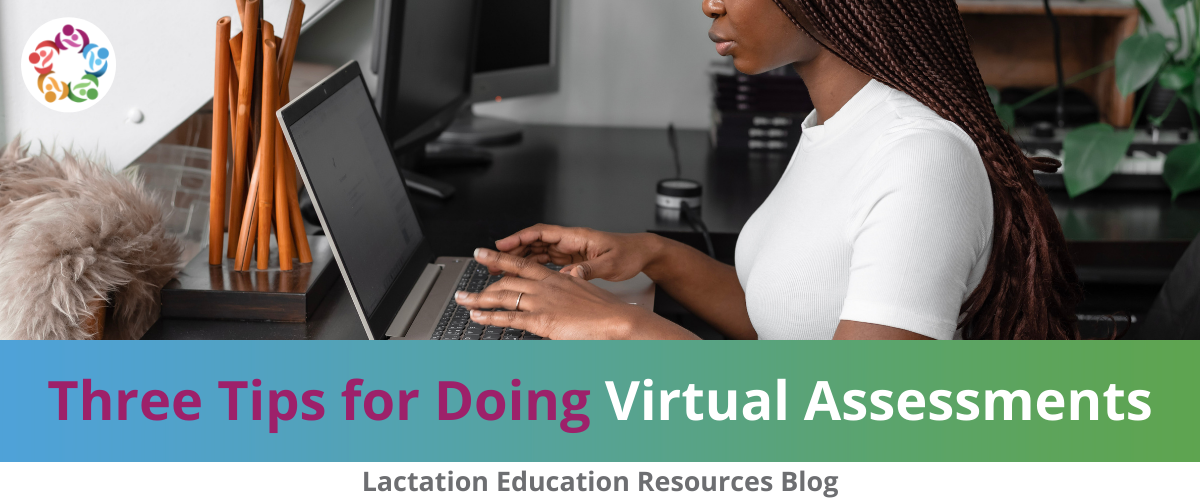
Lactation professionals are detectives.
From the first client contact to the last, your eyes and ears are open for clues.
You catch the hints that might mean an incorrect latch, tethered oral tissues, a milk supply problem.
You read the body language of your client and their baby and gauge how they’re feeling.
But can you pick up these signs and signals on a computer screen?
It can definitely be harder!
Virtual consults have become a big part of many people’s practices, due to the COVID-19 pandemic.
And while there are advantages to seeing clients virtually (no commute for them or you, ease of scheduling, a broader coverage area) there are also challenges.
Doing a great assessment can be one of them.
Try these three things the next time you’re working virtually.
1.) Obtain videos beforehand.
Having your client send you a few key videos before the consult can allow you to do a much better assessment than relying on the live session. Ask for the following:
A video of a nursing session, especially of problems.
This way, you can assess challenges at the breast when they’re happening, in case they don’t happen during the consult.
An oral assessment video.
Oral structures and function can be hard to assess in a virtual consult. Asking your client to attempt an oral assessment video beforehand can give you a better view. Check out a video showing parents how to do this here: How to do an oral motor assessment on your baby on Vimeo.
Miscellaneous other videos.
Consider asking a client to record a pumping session or a flange fit ahead of time, or any other specific issues you think might apply.
2.) Switch between phone and computer for better views.
Having your client use their phone’s camera to show their baby’s latch can allow for much better angles than having them use their computer. But the small screen size will make it harder for them to see what you are demonstrating and teaching. So be prepared to suggest toggling between devices for the best experience.
3.) Practice excellent communication.
A great assessment relies on eliciting all the key information. In a virtual environment, try these tips:
- Remove distractions from your environment.
- Use noise-canceling headphones.
- Look directly at the client. If you need to look away to take notes, tell them first.
- Pay close attention to body language, since it is harder to catch.
- Use both nonverbal cues (nodding encouragingly) and verbal affirmations to let your client know you heard.
- Do not interrupt.
- Ask open-ended questions (instead of yes or no questions) to elicit the most information.
Ready for more? These tips were drawn from LER’s comprehensive course, Mastering the Art of Virtual Lactation Support
In this course, Robin Kaplan, M.Ed., IBCLC, also covers choosing a platform, HIPAA compliance, building your own library of videos to share with clients, handling technical and connectivity problems, and key questions to ask in a virtual consult to evaluate what’s happening with oral motor function, pain, milk transfer, and milk supply.
Kaplan has been an instructor and clinical site mentor for aspiring lactation consultants since 2013. She offers in-person consults to families in San Diego and has provided virtual lactation consultations to families around the world since 2018.

Lactation professionals are detectives.
From the first client contact to the last, your eyes and ears are open for clues.
You catch the hints that might mean an incorrect latch, tethered oral tissues, a milk supply problem.
You read the body language of your client and their baby and gauge how they’re feeling.
But can you pick up these signs and signals on a computer screen?
It can definitely be harder!
Virtual consults have become a big part of many people’s practices, due to the COVID-19 pandemic.
And while there are advantages to seeing clients virtually (no commute for them or you, ease of scheduling, a broader coverage area) there are also challenges.
Doing a great assessment can be one of them.
Try these three things the next time you’re working virtually.
1.) Obtain videos beforehand.
Having your client send you a few key videos before the consult can allow you to do a much better assessment than relying on the live session. Ask for the following:
A video of a nursing session, especially of problems.
This way, you can assess challenges at the breast when they’re happening, in case they don’t happen during the consult.
An oral assessment video.
Oral structures and function can be hard to assess in a virtual consult. Asking your client to attempt an oral assessment video beforehand can give you a better view. Check out a video showing parents how to do this here: How to do an oral motor assessment on your baby on Vimeo.
Miscellaneous other videos.
Consider asking a client to record a pumping session or a flange fit ahead of time, or any other specific issues you think might apply.
2.) Switch between phone and computer for better views.
Having your client use their phone’s camera to show their baby’s latch can allow for much better angles than having them use their computer. But the small screen size will make it harder for them to see what you are demonstrating and teaching. So be prepared to suggest toggling between devices for the best experience.
3.) Practice excellent communication.
A great assessment relies on eliciting all the key information. In a virtual environment, try these tips:
- Remove distractions from your environment.
- Use noise-canceling headphones.
- Look directly at the client. If you need to look away to take notes, tell them first.
- Pay close attention to body language, since it is harder to catch.
- Use both nonverbal cues (nodding encouragingly) and verbal affirmations to let your client know you heard.
- Do not interrupt.
- Ask open-ended questions (instead of yes or no questions) to elicit the most information.
Ready for more? These tips were drawn from LER’s comprehensive course, Mastering the Art of Virtual Lactation Support
In this course, Robin Kaplan, M.Ed., IBCLC, also covers choosing a platform, HIPAA compliance, building your own library of videos to share with clients, handling technical and connectivity problems, and key questions to ask in a virtual consult to evaluate what’s happening with oral motor function, pain, milk transfer, and milk supply.
Kaplan has been an instructor and clinical site mentor for aspiring lactation consultants since 2013. She offers in-person consults to families in San Diego and has provided virtual lactation consultations to families around the world since 2018.